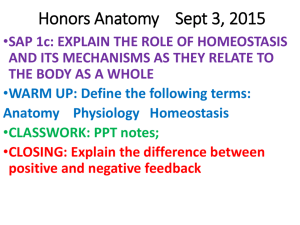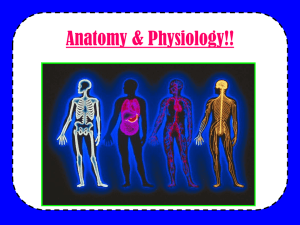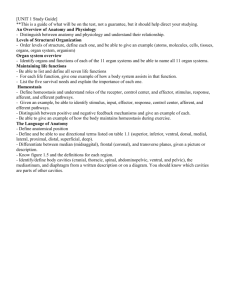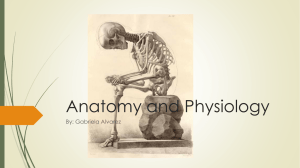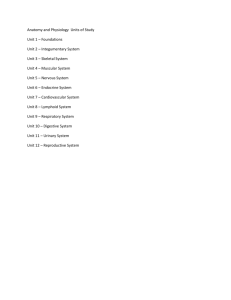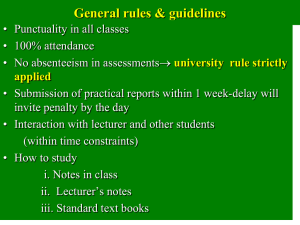Digital Agenda Week of August 25 Check In/Do Now: Tues: Log onto
advertisement
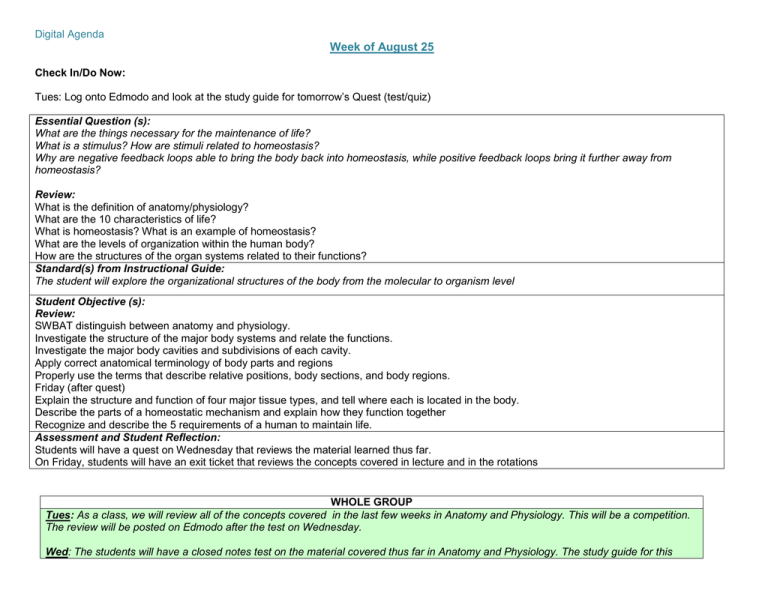
Digital Agenda Week of August 25 Check In/Do Now: Tues: Log onto Edmodo and look at the study guide for tomorrow’s Quest (test/quiz) Essential Question (s): What are the things necessary for the maintenance of life? What is a stimulus? How are stimuli related to homeostasis? Why are negative feedback loops able to bring the body back into homeostasis, while positive feedback loops bring it further away from homeostasis? Review: What is the definition of anatomy/physiology? What are the 10 characteristics of life? What is homeostasis? What is an example of homeostasis? What are the levels of organization within the human body? How are the structures of the organ systems related to their functions? Standard(s) from Instructional Guide: The student will explore the organizational structures of the body from the molecular to organism level Student Objective (s): Review: SWBAT distinguish between anatomy and physiology. Investigate the structure of the major body systems and relate the functions. Investigate the major body cavities and subdivisions of each cavity. Apply correct anatomical terminology of body parts and regions Properly use the terms that describe relative positions, body sections, and body regions. Friday (after quest) Explain the structure and function of four major tissue types, and tell where each is located in the body. Describe the parts of a homeostatic mechanism and explain how they function together Recognize and describe the 5 requirements of a human to maintain life. Assessment and Student Reflection: Students will have a quest on Wednesday that reviews the material learned thus far. On Friday, students will have an exit ticket that reviews the concepts covered in lecture and in the rotations WHOLE GROUP Tues: As a class, we will review all of the concepts covered in the last few weeks in Anatomy and Physiology. This will be a competition. The review will be posted on Edmodo after the test on Wednesday. Wed: The students will have a closed notes test on the material covered thus far in Anatomy and Physiology. The study guide for this assessment is located here: https://docs.google.com/document/d/1JUkb8lmKSaMdE9ppgW5dyJLHEuPQGCMlDGAD8JMiR00/edit?usp=sharing All material highlighted in yellow will be covered. The rest will be covered in class on Friday. DIRECT STATION Fri: Ms. Ferguson will discuss with students the 5 things necessary for the maintenance of life, the tissues of the body, and dive more deeply into the concept of homeostatic mechanisms. She will be using the following Prezis 1) Starting from slide 12 http://www.learner.org/courses/envsci/in teractives/ecology/ 2) http://prezi.com/jashaohk6zdn/homeosta sis/ 3) And if there is enough time, https://docs.google.com/a/blastla.org/pr esentation/d/1z4TGnWygjo19KD4fMip9vu RqU8N4Uk2GyASv5gBPtu8/edit#slide=id.i 0 COLLABORATIVE STATION Fri: Go through the test you got back and check over questions that you got wrong. Ask friends about the ones you got wrong and make sure you understand why you got it wrong. Be sure to notify Ms. Ferguson of any discrepancies. Once you are done, make a slideshow through google docs on each of the 5 requirements necessary to maintain life: 1) Nutrients for energy 2) Oxygen for cellular respiration 3) Water for most metabolic reactions, lubrication, etc 4) Heat to maintain 37 degree C body temp, enzyme action, etc 5) Pressure for breathing and filtering blood through kidneys Vocabulary Padlet Wall (we will be adding to this as the week progresses) AFTER QUEST Stimulus Receptor Input Output Response Effector Control Center Afferent pathways Efferent pathways Epithelial tissue Connective Tissue INDEPENDENT STATION Fri: Follow this link and go through the tutorial. You will need headphones for this activity. http://higheredbcs.wiley.com/legacy/college /sarafino/0470129166/animations/homeo1a /frameset.htm Take notes in your notebook on the material covered in the tutorial. Answer the following questions: 1) What is an effector? Example? 2) What is a control center? Example? 3) What is an effector? Example? 4) What is a stimulus? 5) What are two examples of negative feedback mechanisms? 6) What are two examples of positive feedback mechanisms? If you finish early, go through this: http://anatomyandphysiologyi.com/homeost asis-positivenegative-feedbackmechanisms/ and look for definitions for your padlet word wall Nerve Tissue Muscle Tissue Hypothalamus
